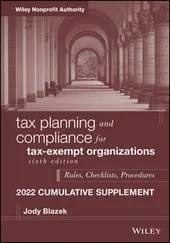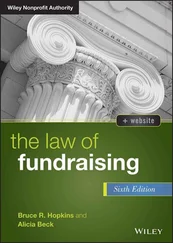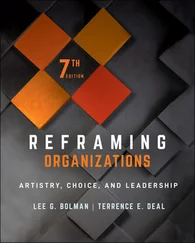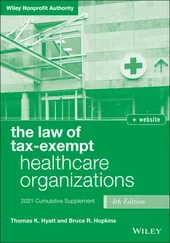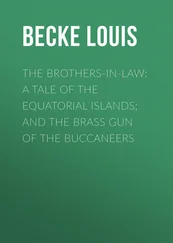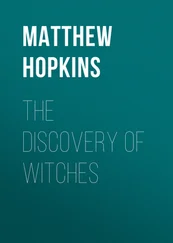Bruce R. Hopkins - The Law of Tax-Exempt Organizations, 2021 Cumulative Supplement
Здесь есть возможность читать онлайн «Bruce R. Hopkins - The Law of Tax-Exempt Organizations, 2021 Cumulative Supplement» — ознакомительный отрывок электронной книги совершенно бесплатно, а после прочтения отрывка купить полную версию. В некоторых случаях можно слушать аудио, скачать через торрент в формате fb2 и присутствует краткое содержание. Жанр: unrecognised, на английском языке. Описание произведения, (предисловие) а так же отзывы посетителей доступны на портале библиотеки ЛибКат.
- Название:The Law of Tax-Exempt Organizations, 2021 Cumulative Supplement
- Автор:
- Жанр:
- Год:неизвестен
- ISBN:нет данных
- Рейтинг книги:5 / 5. Голосов: 1
-
Избранное:Добавить в избранное
- Отзывы:
-
Ваша оценка:
- 100
- 1
- 2
- 3
- 4
- 5
The Law of Tax-Exempt Organizations, 2021 Cumulative Supplement: краткое содержание, описание и аннотация
Предлагаем к чтению аннотацию, описание, краткое содержание или предисловие (зависит от того, что написал сам автор книги «The Law of Tax-Exempt Organizations, 2021 Cumulative Supplement»). Если вы не нашли необходимую информацию о книге — напишите в комментариях, мы постараемся отыскать её.
The Law of Tax-Exempt Organizations, 2021 Cumulative Supplement — читать онлайн ознакомительный отрывок
Ниже представлен текст книги, разбитый по страницам. Система сохранения места последней прочитанной страницы, позволяет с удобством читать онлайн бесплатно книгу «The Law of Tax-Exempt Organizations, 2021 Cumulative Supplement», без необходимости каждый раз заново искать на чём Вы остановились. Поставьте закладку, и сможете в любой момент перейти на страницу, на которой закончили чтение.
Интервал:
Закладка:
These guidelines state that a charity may provide crisis counseling, rescue services, or emergency aid (such as blankets or hot meals in the immediate aftermath of a disaster) without a showing of financial need. That is, provision of these services to the distressed in the immediate aftermath of a disaster serves a charitable purpose regardless of the financial condition of the recipients.” However, the IRS guidelines state that “as time goes on and people are able to call upon their individual resources, it may become increasingly appropriate for charities to conduct individual financial needs assessments.” Said the IRS: “While those who may not have the resources to meet basic living needs may be entitled to such assistance, those who do not need continued assistance should not use charitable resources.”
The IRS states that an individual who is eligible for assistance because the individual is a victim of a disaster or emergency hardship has “no automatic right” to a charity's funds. For example, a charitable organization that provides disaster or emergency hardship relief does not have to make an individual whole, such as by rebuilding the individual's uninsured home destroyed by a flood or replacing an individual's income after the individual becomes unemployed as the result of a civil disturbance. This “issue,” the IRS writes, is “especially relevant when the volume of contributions received in response to appeals exceeds the immediate needs.” The IRS states that a charitable organization “is responsible for taking into account the charitable purposes for which it was formed, the public benefit of its activities, and the specific needs and resources of each victim when using its discretion to distribute its funds.”
The IRS guidelines address the matter of charitable organizations' documentation obligations. The rule is that a charitable organization in this context must maintain “adequate records” to show that the organization's payments further its charitable purposes and that the victims served are “needy or distressed.” Moreover, these charities are required to maintain “appropriate records” to show that they have made distributions to individuals after making “appropriate needs assessments” based on the recipients' financial resources and their physical, mental, and emotional well‐being.
The IRS states that this documentation should include a complete description of the assistance provided; the costs associated with provision of the assistance; the purpose for which the aid was given; the charity's objective criteria for disbursement of assistance under each program; how the recipients were selected; the name and address of, and the amount distributed to, each recipient; any relationship between a recipient and directors, officers, and/or key employees of, or substantial contributors to, the charitable organization; and the composition of the selection committee approving the assistance.
With respect to short‐term emergency aid, the IRS guidelines recognize that charities proving that type of assistance are only expected to maintain records showing the type of assistance provided; the criteria for disbursing assistance; the date, place, and estimated number of victims assisted; the charitable purpose intended to be accomplished; and the cost of the aid. By contrast, organizations that are distributing longer‐term assistance are required to keep more detailed records.
The IRS guidance differentiates among employer‐sponsored programs utilizing public charities, donor‐advised funds, and private foundations.
(ii) Public Charities.This guidance states that, “[b]ecause public charities typically receive broad financial support from the general public,” their operations are generally more transparent and are subject to greater public scrutiny.” 48 Accordingly, the IRS states, public charities may provide a “broader range of assistance” to employees than can be provided by donor‐advised funds or private foundations. The IRS writes that an employer can establish an employer‐sponsored public charity to provide assistance programs to respond to any type of disaster or employee emergency hardship situations, as long as the employer involved does not exercise “excessive control” over the charitable organization. Generally, the IRS observes, employees contribute to the public charity, and rank and file employees constitute a “significant portion” of the organization's governing board.
The IRS states that “[t]o ensure the program is not impermissibly serving the related employer,” these requirements must be met: (1) the class of beneficiaries must constitute a charitable class, (2) the recipients must be selected on the basis of an “objective determination of need,” and (3) the recipients must be selected by an independent selection committee or adequate substitute procedures must be in place to ensure that any benefit to the employer is incidental and tenuous. As to this third requirement, the charity's selection committee is independent if a majority of its members consists of persons who are not in a position to exercise substantial influence over the affairs of the employer.
If these requirements are met, the public charity's payments to the employer‐sponsor's employees and their family members in response to a disaster or emergency hardship are presumed to be made for charitable purposes and not to result in taxable compensation to the employees.
(iii) Donor‐Advised Funds.As to donor‐advised funds, 49 the IRS observes that, in general, grants cannot be made from the funds to individuals. 50 The agency notes, however, its recognition of an exception for certain employer‐related funds established to benefit employees and their family members who are victims of a qualified disaster. 50.1
Specifically, a donor‐advised fund can make grants to employees and their family members where (1) the fund serves the single identified purpose of providing relief from one or more qualified disasters; (2) the fund serves a charitable class; (3) recipients of grants are selected on the basis of an objective determination of need; (4) the selection of recipients of grants is made using either an independent selection committee or adequate substitute procedures to ensure that any benefit to the employer is incidental and tenuous; 50.2 (5) no payment is made from the fund to or for the benefit of any trustee, director, or officer of the sponsoring organization, public charity, or members of the fund's selection committee; and (6) the fund maintains adequate records to demonstrate the recipients' need for the disaster assistance provided.
(iv) Private Foundations.Under current IRS policy, employer‐sponsored private foundations may provide financial assistance to employees or family members affected by a qualified disaster 50.3 as long as certain safeguards are in place to ensure that the assistance is serving charitable purposes, rather than the employer's business purposes. 50.4 Thus, the IRS will presume that payments in response to a qualified disaster made by a private foundation to employees or their family members of an employer that is a disqualified person with respect to the foundation are consistent with the foundation's charitable purposes if (1) the class of beneficiaries is “large or indefinite” (that is, is a charitable class), (2) the recipients are selected on the basis of an “objective determination of need,” and (3) the selection is made using either an independent selection committee or “adequate substitute procedures” so as to ensure that any benefit to the employer is incidental and tenuous. 50.5 A foundation's selection committee is independent if a majority of the members of the committee consists of persons who are not in a position to exercise substantial influence over the affairs of the employer.
Читать дальшеИнтервал:
Закладка:
Похожие книги на «The Law of Tax-Exempt Organizations, 2021 Cumulative Supplement»
Представляем Вашему вниманию похожие книги на «The Law of Tax-Exempt Organizations, 2021 Cumulative Supplement» списком для выбора. Мы отобрали схожую по названию и смыслу литературу в надежде предоставить читателям больше вариантов отыскать новые, интересные, ещё непрочитанные произведения.
Обсуждение, отзывы о книге «The Law of Tax-Exempt Organizations, 2021 Cumulative Supplement» и просто собственные мнения читателей. Оставьте ваши комментарии, напишите, что Вы думаете о произведении, его смысле или главных героях. Укажите что конкретно понравилось, а что нет, и почему Вы так считаете.




